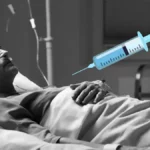MAiD / Euthanasia
Macabre discovery at Nazi euthanasia castle sheds light on current debate
Last month, investigators “found a layer of human ashes and bone remains several centimeters thick, measuring approximately 460 square meters” at “depths of 80 centimeters to 1.50 meters” just outside Hartheim Castle near the Austrian city of Linz. The crushed and incinerated bodies were victims of the Third Reich’s T-4 euthanasia program, which ended the lives of between 70,000 and 20,000 people that the Nazis deemed “life unworthy of life.”
Hartheim Castle, which is now a memorial site, was one of the eight centers where Nazi doctors murdered people with disabilities, mental illnesses, and other people categorized as “useless eaters.” Between May 1940 and November 1944, around 30,000 people were murdered in gas chambers, burned in a specially constructed crematorium, and dumped in a tributary of the Danube, or, we now know, on the castle grounds. The victims also included Dutch Jews as well as prisoners from Spain, Poland, and France.
Hartheim Castle was selected as a killing center immediately after the Aktion T-4 euthanasia program was launched in October 1939, when Hitler personally signed a note to his doctor Karl Brandt and Reichsleiter Philipp Bouhler authorizing the killing. Despite protest from some religious figures including, most notably, Clemens August Count von Galen, Bishop of Münster, the Nazis insisted that the murders were “mercy killings.” It would be better for everyone—society, their families, and certainly themselves—if these people did not exist.
In December 2024, investigators noted anomalies in the soil on the castle grounds on aerial photographs and followed up with ground-penetrating radar and targeted drilling that confirmed the presence of the dead. “Investigators based their suspicions on testimonies from witnesses of the time, according to which human ashes had been dumped into the Danube River for a time,” said Florian Schwanninger, director of the Learning and Commemoration Center of Hartheim Castle. “This became too conspicuous for the Nazis over time, which is why from an unknown point in time, the ash was buried.”
The 490 square meter site will likely be dedicated as a war grave. “The crimes of the Nazi era must never be forgotten,” Austrian Interior Minister Gerhard Karner stated. “Only those who know the past can shape the future,” added Upper Austria’s Governor Thomas Stelzer in a joint press release. Indeed, this discovery comes as the euthanasia debate is once again raging in many countries across the West—and our current debates contain many chilling echoes of Nazi logic that we would do well to note.
In Canada, the state broadcaster published a report detailing the healthcare savings legal euthanasia would bring; a Guernsey politician called for the legalization of euthanasia on the same grounds, going so far as to demand the disclosure of the total costs of providing care to people who wished to die over the last five years. The Nazis made a nearly identical argument, creating propaganda posters claiming that caring for people with disabilities could cost the state up to 60,000 Reichsmarks per person over their lifetimes.
Matthew Parris, a UK newspaper columnist and former Tory MP, made this argument explicit in the Times last year in a column titled “We can’t afford a taboo on assisted dying,” writing that, “The argument against [euthanasia] is that pressure will grow on the terminally ill to hasten their own deaths—and that’s not a bad thing.” Parris went further, writing that within ten years of euthanasia being legalized, it would be “seen as a normal road for many to take, and considered socially responsible—and finally, urged upon people.”
Parris, of course in no way a Nazi but a liberal pro-EU Tory, is perhaps unaware of how his arguments sound in German, but his rhetoric is nearly identical. “For a society as much as for an individual, self-preservation must shine a harsh beam on the balance between input and output,” he wrote. “…If I’m right, our growing interest in assisted dying may reflect a largely unconscious realization that we simply cannot afford extreme senescence or desperate infirmity for as many individuals as our society is producing.”
In short: “our culture is changing its mind about the worth of old age.” The elderly and infirm will soon get the hint that their “time is up,” says Parris, and that’s a good thing. Or as the headline of Parris’s 2015 column in the Spectator making a similar case succinctly put it: “Soon we will accept that useless lives must end.” Much like the Nazis, Parris argued that “If the law does not lead, it will follow—at the root the reason is Darwinian.”
Indeed, George Morris cited these sinister echoes in the journal History Today earlier this year. Dr. Charles Killick Millard founded the Voluntary Euthanasia Society in 1935; “voluntary” was rather ominously dropped in 1955 (it was reinstated in 1969), and the organization became “Dignity in Dying” in 2005. Dignity in Dying is the primary lobby group currently pushing for legal euthanasia in the UK (in Canada, it is their powerful counterpart Dying with Dignity). As Morris noted, the group has faced many setbacks over the years—not least because the association between VELS and the Nazi euthanasia regime was sometimes explicit rather than implicit:
[A]fter the war, revulsion at the Nazi euthanasia programme was a setback to the cause. When a bill was introduced to the Lords in 1950 it provoked such opposition that it was withdrawn without a vote. The association of VELS with the Nazi regime was simplistic, but not entirely unfair. Millard’s openness to fellow travellers meant that in 1950 he lobbied for the release from British custody of Sigbert Ramsauer, who had been an SS camp doctor at Dachau, Mauthausen and Loibl, on the grounds that the medical killings he had carried out were euthanasia.
Ramsauer was a feared surgeon in the concentration camps and killed several people by injecting gasoline. He was sentenced to life imprisonment by a British military court in 1947 but pardoned and released early due to illness in 1954. He eventually rose to the position of chief physician at the Klagenfurt State Hospital and ran his own practice. Before his death in 1991, the unrepentant murderer stated in an interview: “I had no reason, no incentive, to hate anyone. But I did—let’s put it this way—feel these people inferior.” That Millard considered him a “fellow traveler” is indicative, to say the least.
Read the rest of this column at The European Conservative








